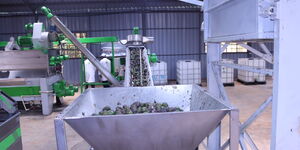Farming is a costly venture especially when the cost of production is high and the input overrides the output.
Farmers would always gravitate towards a farming method that not only improves their yields but also is easily available.
Well, the Azolla farming method is one kind of technique that has seen farmers benefit from its high protein levels than most green forage crops.
Kenyans.co.ke sought to find out what this technique was and its use by farmers.
According to FarmbizAfrica, Azolla is an aquatic fern that serves as a rich source of high-quality plant protein feed to supplement traditional livestock feed for poultry, pigs, fish, goats and cows.
It can also serve as green fertiliser.
To develop Azolla;
- A water body is made, preferably under the shade of a tree, with the help of a silpauline sheet. Silpauline is a polythene tarpaulin which is resistant to ultraviolet radiation in sunlight. A pit of 2 x 2 x 0.2 m is dug as a first step.
- All corners of the pit should be at the same level so that a uniform water level can be maintained. The pit is covered with plastic gunnies to prevent the roots of the nearby trees from piercing the silpauline sheet, which is spread over the plastic gunnies.
- About 10 – 15 kg of sieved fertile soil is uniformly spread over the silpauline sheet. A slurry made of 2 kg cow dung and 30 g of Super Phosphate mixed in 10 litres of water, is poured onto the sheet. More water is poured to raise the water level to about 10 cm.
- About 0.5 – 1 kg of fresh and pure culture of Azolla is placed in the water. This will grow rapidly and fill the pit within 10 – 15 days. From then on, 500 – 600 g of Azolla can be harvested daily.
- The crop can be maintained by adding one kilogram of cow dung and an optional two 80-100 grams of superphosphate every two weeks.
Azolla is a water-floating plant that only needs a few plants to be able to multiply in a pond that is fertigated. (the practice of applying fertilizer solutions with irrigation water).
You then harvest using a sieve, rinse it and press to expel excess water and it's ready to be fed to livestock.
Kim Kabuu a farmer in Olkalou, Nyahururu while speaking to Kenyans.co.ke revealed that he settled for Azolla because of its affordability and high returns.
“I settled for Azolla because it's cheap to grow, and maintain and yields good harvest in less than 21 days. It is a quality protein with every part being edible for livestock. In this season where crops have failed and yield is fewer, my feeds have almost doubled, had to look for an alternative,” he stated.
Kabuu equally disclosed that he had seen great improvements in the number of eggs from his turkey, geese, ducks and chicken that he keeps.
“Rearing turkey chicken has been easier with Azolla supplement since turkey chicks need a daily protein of 28% crude protein yet the market has chick mash at 18% crude protein and broiler starter mash at 23-24% crude. To formulate a balanced feed for them Azolla has made that possible,” he stated.
He also stated that his yields improved as compared to when he reared chicken without Azolla.
"In every 2.5months I have had over 60 turkey eggs unlike before they would take 4-5 months before resuming laying. For chicken, I have recorded 10 more eggs unlike before I had 50% or less laying.
On how he gets the Azolla plant, Kabuu revealed that he bought them as a plant.
"You buy as a plant from a farm that is growing them. It is not inform of seeds or seedlings. Azolla reproduces asexually, so one plant gives about another plant and it doubles its biomass in less than 3 days. A Kg of Azolla ranges from Ksh1000 to Ksh1500 depending on the farmer," he remarked.
However, Kabuu gave precautions on how to handle the Azolla plant.
"Azolla is fed by manure or fertilizer. If the manure has too much nitrogen like rabbit or chicken manure azolla will die," he warned.
According to Kabuu, water has to be changed every 4-6 months to prevent the nitrogen build up.
"Azolla only needs a little nitrogen because it's able to fix nitrogen from the atmosphere, it mainly needs phosphorous to multiply. Goat, sheep and cattle manure has worked well," he argued.












